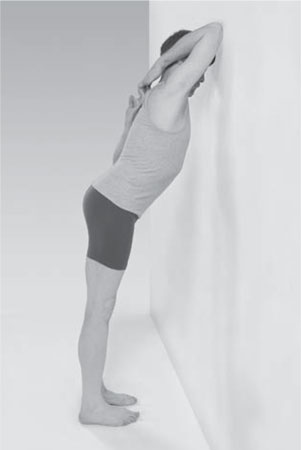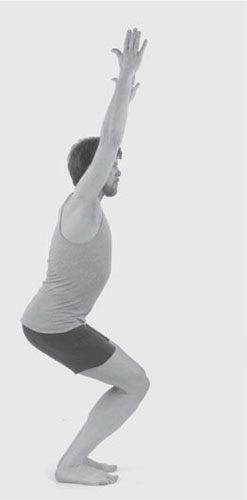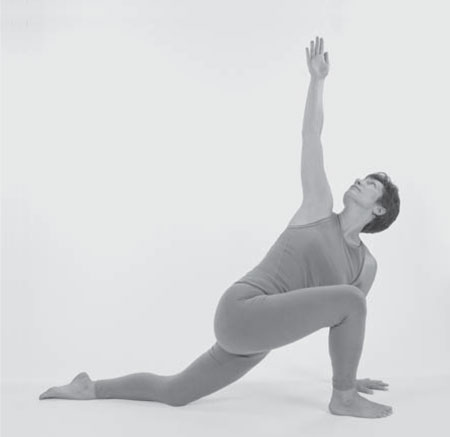Yoga for a Healthy Lower Back (43 page)
Read Yoga for a Healthy Lower Back Online
Authors: Liz Owen


FIG. 6.4

FIG. 6.5
Chair Pose
Stretch and Strengthen | Utkatasana
This pose is called Chair Pose because in it, your body looks like it's sitting in a chair. But this pose's Sanskrit name,
Utkatasana,
is translated into
English as “Fierce Pose.” You'll start by opening your shoulders and side trunk, then move into a supported version of Chair Pose to warm up your back, shoulders, and chest before coming into full Chair Pose. When you practice Chair Pose after warming up, you'll feel like you are settling down into a chair that was made to fit your body, rather than moving into the fierce upper back stretch (and leg strengthener) that the Sanskrit name suggests.
Shoulder/Side Trunk Stretch
Stand about a foot from a wall, facing it. Stand farther away if your shoulders are very flexible. Draw your left arm behind your back and slowly lift your forearm and hand up along your spine until you feel a comfortable, sustainable stretch in your left shoulder. Lift your right arm up toward the ceiling and take your right hand to the nape of your neck. Crawl your right hand down your spine until your hands meet (
fig. 6.6
). If they don't, hold a belt with both hands.
Place your right elbow against the wall. Look to see that both sides of your chest are facing the wall evenly, and then look straight at the wall. Press your hips away from the wall and press your chest toward it as you reach your right elbow up the wall. You should feel a good stretch around the upper right trunk, shoulder, and armpit. Hold Shoulder/Side Trunk Stretch for fifteen to twenty seconds, bend your knees slightly to come out of the stretch, then repeat it to your left. If you have a shoulder injury, make sure you only go as far as your shoulder enjoys a comfortable stretch.

FIG. 6.6
Supported Chair Pose
Stand facing a wall in Mountain Pose the same way you just did for Shoulder/Side Trunk Stretch, this time with your feet about eighteen inches from the wall. Lift your arms up into Upward Hand Pose. Place your hands flat on the wall, a little wider than shoulders' width apart, and stretch your arms up along the wall. Gaze straight at the wall. Bend your knees and drop your hips, coming into Supported Chair Pose.
Press your chest toward the wall while you stretch your arms up (do not bend your elbows!), mindfully lengthening your lower back rather than overarching it (
fig. 6.7
). Bring your chest to the wall before your head, then touch your noseânot your foreheadâto the wall. You should feel a stretch all around your upper back and shoulders, and across your upper chest. Hold for fifteen to twenty seconds, stretch your legs straight, and release the pose.

FIG. 6.7

FIG. 6.8
Full Chair Pose
Begin in Upward Hand Pose, this time with your palms facing each other. Elongate your body upward as you inhale, and with an exhalation bend your knees, drop your hips, and lean slightly forward (
fig. 6.8
). Your eyes should gaze straight ahead. Scoop your tailbone in and up to maintain length in your lower back, and stretch upward through your trunk, shoulders, and arms. Re-create the actions you found in your upper back, chest, and armpits when you practiced steps 1 and 2.
Are you able to connect with the feeling of fierceness of Full Chair Pose
now? In the pose, your thighs, hips, and abdominal core musculature should be completely engaged to help your upper back open as much as possible. Hold Full Chair Pose for ten to twenty seconds, breathing evenly and fully. To come out of the pose, stretch your arms, trunk, and legs upward, come back into Upward Hand Pose, and release your arms. Stand in Mountain Pose for a few breaths and feel spaciousness and openness in your upper back and shoulders.
Eagle Pose
Balance and Strengthen | Garudasana
Stand in Mountain Pose. Stretch your arms straight out from your shoulders and as you exhale, cross your right arm over your left arm at your elbows. Face your inner forearms away from each other, and place your left fingers on the palm of your right hand. Your thumbs should point toward your face. If your hands don't reach each other, hold a belt to connect them. If you can't cross your elbows, give yourself a hug by holding each shoulder with the opposite hand. If your elbows are crossed, gaze between your forearms.
Lift your arms upward from the elbows, and breathe into the tops of your shoulders and upper back. Feel your shoulder blades wrapping around to the sides of your trunk and feel a great stretch deep in the weave of your upper trapezius and rhomboid muscles.
You're halfway into Eagle Pose. You can remain here and just enjoy the stretch to your upper back. But if you're game to practice full Eagle Pose, you'll also get some nice openness across your sacral band. Here's the rest of the pose:
Bend your knees, just like you did in Chair Pose. Shift your weight onto your right foot and walk your left foot forward and around your right leg. Pick up your left foot and wrap it behind your outer right shinâany amount possible (
fig. 6.9
). This action comes from rolling your upper thighs inward, which brings your hips into internal rotation and spreads the sacral band.
Stay in Eagle Pose for fifteen to twenty seconds, mindfully observing how your body is continually finding its balance. Consider the sharpness of an eagle's movements and intelligence, and bring those qualities into your body and mind. To come out of Eagle Pose, first undo your legs and then follow with your arms. Repeat to the opposite side.

FIG. 6.9
Revolved Lunge Pose
Stretch | Parivrtta Anjaneyasana
Begin in
Low Lunge Pose
with your right leg forward. Exhaling, place your left hand on the floor about twelve inches to the left of your right foot. If you can't easily reach the floor, place your hand on a block. Place your right hand on your right hip and as you inhale, elongate your trunk away from your hips. Exhaling, turn your trunk up toward the ceiling, any amount possible. Repeat the steps of elongating and turning your trunk along with the rhythm of your breath. When you've reached a comfortable, sustainable stretch, reach your right arm up toward the ceiling. To stretch your neck, rotate your head around the axis of your spine, just like you did in the
Neck Meditation
. Gaze forward, or look up at your raised hand for more stretch in your neck (
fig. 6.10
).
Revolved Lunge Pose stretches and tonesthe muscles of your trunk and hips. It's moreimportant to elongate your trunk than it is toturn it, because in order to protect the spinaldisks, the spine needs to lengthen before ittwists. As you take your right arm up to theceiling, be sure to draw your shoulders awayfrom your neck and press your shoulderblades forward to help support your upperchest.
Hold Revolved Lunge Pose for fifteento twenty seconds and slowly bring yourright arm down. Place both hands on thefloor and take your right leg back to meetyour left leg. Rest in
Child's Pose
for a few breaths before you practice Revolved Lunge Pose to your left.

FIG. 6.10
Revolved Triangle Pose
Stretch and Strengthen | Parivrtta Trikonasana
Revolved Triangle Pose elongates all the myofascia of your lower, middle, and upper back, and it strengthens the stabilizing muscles of the legs and hips. You'll begin about six inches away from a wall, facing it. Walk your feet four and a half feet apart, and turn your right foot out and your left foot in. Place a block by the arch side of your right foot, or use a chair for support. Turn your torso to the right and swing your left arm up and around to the right. Bend forward at your hips, bring your left hand onto the block or chair, and place your right hand on your right hip. Turn your back into the wall. Elongate your trunk forward with each inhalation, and turn more deeply into the twist with each exhalation. Finally, lift your right arm up to the ceiling.